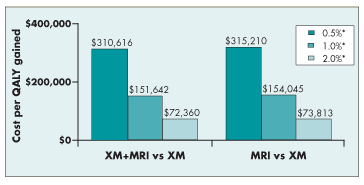Cost-effectiveness of MRI breast cancer screening in high-risk women depends on the nature of the risk
Among women at high risk for breast cancer, screening with magnetic resonance imaging is clearly cost-effective in those with BRCA 1/2 mutations but somewhat less so in those whose elevated risk is due to other factors, according to a new study.
SAN ANTONIO-Among women at high risk for breast cancer, screening with magnetic resonance imaging is clearly cost-effective in those with BRCA 1/2 mutations but somewhat less so in those whose elevated risk is due to other factors, according to a new study.
“To date, only one study (JAMA 295:2374-2384, 2006) has examined the cost-effectiveness of [breast] MRI in the United States,” said lead author Charu Taneja, MPH, a research associate at Policy Analysis Inc., Brookline, Massachusetts.
Addressing the Gaps
That study modeled the cost-effectiveness of various screening strategies among BRCA 1/2 carriers according to the age at which screening started and ended, but did not include other women with a high lifetime risk of breast cancer (for whom MRI is currently recommended) and did not assess the cost-effectiveness of screening with only MRI, Ms. Taneja told ONI in an interview.
“To address these gaps in the existing literature, we undertook a study of the cost-effectiveness of MRI screening, alone and as an adjunct to mammography, vs mammography alone in a given year of an established screening program among US women at high risk of developing breast cancer,” she said.
The researchers used a decision-analytic model depicting the consequences of screening in women at high risk of having a previously undetected breast cancer.
In the study, presented at the 2007 San Antonio Breast Cancer Symposium (abstract 1036), all women at high risk for breast cancer (because of BRCA mutations, family history, or other factors) were screened once at model entry with MRI alone, mammography alone, or both.
The model predicts the number of women correctly and incorrectly diagnosed with each strategy and the consequences in terms of costs (for initial screening, diagnostic work-up, and treatment) and life expectancy.
In the model, those with positive results underwent further diagnostic evaluation and, in the case of true positives (invasive cancer or ductal carcinoma in situ), breast cancer treatment. Those with false-negative results received a breast cancer diagnosis with more advanced disease within 12 months and then treatment.
On the basis of published reports, the investigators estimated the prevalence of undetected breast cancer at screening to be 4.0% among women with BRCA mutations and variable-0.5%, 1.0%, or 2.0%-among other high-risk women.
The sensitivity and specificity of the screening tests, based on two published reference sources, were 40% and 94.5%, respectively, for mammography alone; 72.6% and 87.6% for MRI alone; and 90.2% and 84.1% for MRI plus mammography.
Study results indicated that for every 10,000 BRCA 1/2 mutation carriers screened, the number of true positives was 160 with mammography alone, 290 with MRI alone, and 361 with the combination; the respective number of false positives was 528, 1,190, and 1,526.
For every 10,000 other high-risk women screened, the number of true positives was 20 to 80 with mammography alone, 36 to 145 with MRI alone, and 45 to 180 with mammography and MRI in combination (depending on the predicted prevalence of undetected breast cancer). The corresponding number of false-positive findings was 539 to 547, 1,215 to 1,234, and 1,558 to 1,582.
Number of QALYs gained
Among 10,000 women with a BRCA 1/2 mutation, the number of quality-adjusted life-years (QALYs) gained was 205,835 with mammography alone, 206,091 with MRI alone, and 206,113 with the combination; corresponding costs were roughly $20.6 million, $27.1 million, and $27.6 million.
Among 10,000 other high-risk women, the number of QALYs gained ranged from 206,225 to 206,439 with mammography alone, from 206,378 to 206,470 with MRI alone, and from 206,391 to 206,473 with the combination (depending on the prevalence of undetected breast cancer); respective costs were $2.9 to $9.0 million, $12.7 to $18.1 million, and $13.6 to $18.9 million.
The main results indicated that “screening with MRI alone or in combination with mammography in women with BRCA 1/2 mutations is cost-effective by current standards in comparison with mammography alone,” Ms. Taneja said.
For women with these mutations, the cost of combined mammography and MRI vs mammography alone was $25,277 per QALY gained; the cost of MRI alone vs mammography alone was $25,340 per QALY gained, well below the benchmark for cost-effectiveness of a treatment or procedure of $50,000 per QALY gained.
For other high-risk women, the cost per QALY gained was higher but decreased as the prevalence of undetected breast cancer at screening increased (see Figure). Even for the highest prevalence considered in these women (2%), the cost was above the $50,000/QALY gained benchmark.
“Our study suggests that MRI screening (with mammography or alone) of women at high risk of breast cancer due to BRCA 1/2 mutations represents a cost-effective use of health care resources,” Ms. Taneja concluded.

Cost-effectiveness of MRI screening in high-risk women without BRCA 1/2 mutations. XM = mammography, MRI = magnetic resonance imaging, QALY = quality-adjusted life-years.
*Expected prevalence of undetected breast cancer at screening.